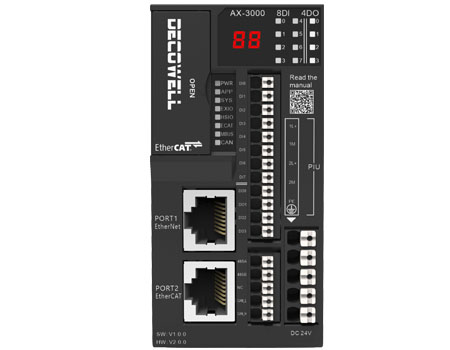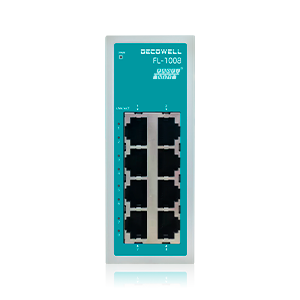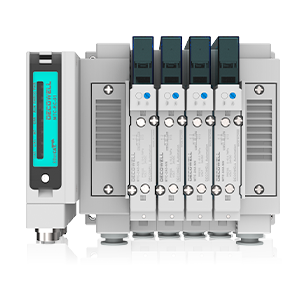
Lithium industry
Decowell remote I/O module is used in power battery laser film making machine
Power battery laser film-making machine

Laser cutting, also known as filmmaking, refers to the use of laser to cut the pole piece exposed foil after rolling into the pole piece ear. The
process is divided into three steps: pre-cutting (high precision and air cleanliness) - pole piece forming (die cutting and laser cutting - pole
piece forming).
01 Industry process
Laser cutting is a process that uses a high-power density laser beam to achieve cutting. Laser cutting has the advantage of no physical wear,
flexible cutting shape, edge quality control, higher accuracy, and lower operating costs, which is conducive to reducing manufacturing costs,
improving production efficiency, and significantly shortening the die-cutting cycle of new products.
In power battery production, laser cutting is mainly used in the battery pole piece manufacturing process in the front-end process.
Including laser pole piece cutting and forming of positive and negative electrodes, laser pole piece cutting, laser pole piece striping, and laser
cutting of diaphragms; among them, laser pole piece forming is currently the most important application of laser cutting in the field of lithium
battery manufacturing.
According to the current requirement, the positive and negative electrodes are cut into corresponding numbers of tabs, and one tab is cut every
certain period. The spacing is mainly calculated by formula, and the thickness of the diaphragm and the tab wrapping is considered to be
cumulatively calculated.
This process requires attention to laser dust removal and cleaning of the laser base, otherwise, it is easy to cause joint phenomena, continuous
cutting, and excessive dust leading to large self-discharge and other adverse consequences. Dust is something that needs to be focused on in
this process. The size of dust particles greatly affects the performance and safety of the battery. In addition to the overall dust removal in the
workshop, the dust removal of the equipment should also be done well. Therefore, there is also a kind of filmmaking that uses die-cutting to
control dust, but burrs are difficult to control.
Spot welding is to leave a blank in the middle, then weld the positive electrode to the aluminum sheet, and the negative electrode to the copper
sheet as the tab. Ultrasonic welding is used, so we call it spot welding.
02 Module application

Master station: Beckhoff TwinCAT3 system;
Applicable process section: Film-making process;
Project I/O configuration: Single machine digital signal about 300 points, high-speed counting *3;
Project overview: This project model has the function of cutting the pole ears of the positive and negative plates of lithium batteries on one
side or both sides and can produce 8 poles at the same time.
A single standard machine uses multiple EX card modules of our company, among which 3 sets of high-speed counting modules are used to
collect motor shaft signals for feeding the power battery pole ears.
The basic principle of laser filmmaking is to use a high-power density laser beam to irradiate the cut battery pole piece, so that the pole piece
is quickly heated to a very high temperature, and quickly melts, vaporizes, ablates, or reaches the ignition point to form a hole. As the beam
moves on the pole piece, the hole continuously forms a very narrow slit to complete the cutting of the pole piece.
Application highlights:
Compared with traditional die-cutting, laser film production has high production efficiency and good process stability. Our remote I/O can
provide it with a more efficient and stable signal processing solution.
03 Equipment topology diagram
04 Decowell EX series remote I/O

Product features:
1. Stable communication, fast response, convenient operation, and high efficiency;
2. Rich bus protocols, supporting multiple communication protocols, such as EtherCAT, PROFINET, DeviceNet, CC-Link, Ethernet/IP,
Modbus-RTU, CC-Link IEF Basic, etc.;
3. Rich signal types, which can meet factory automation and process automation control. Supports digital quantity, analog quantity,
temperature module, encoder module, and free communication module;
4. Compact structure, small module size, a single I/O module supports up to 32 digital signal points;
5. Strong expansion capability, a single adapter can expand up to 32 I/O modules, and the coupler scans quickly;
6. Easy to use, standard DIN35 rail installation, plug-in terminals, tool-free installation.






















